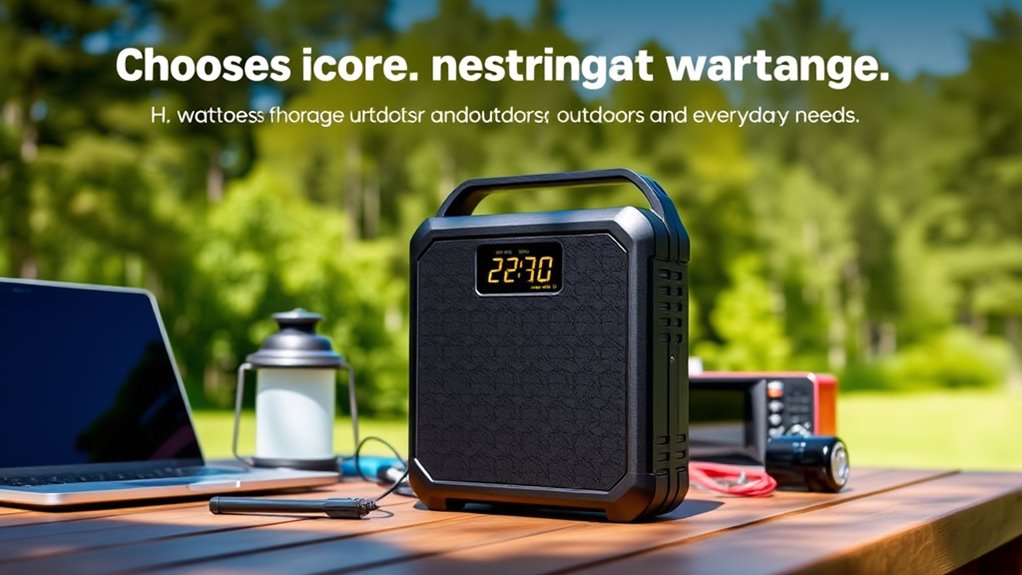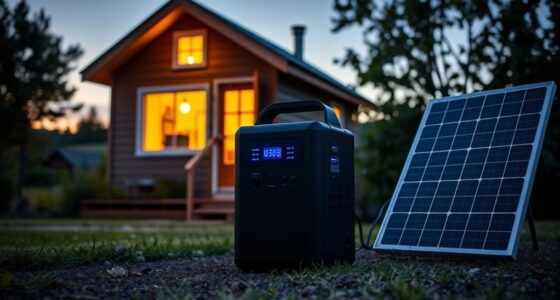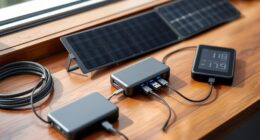Whether you need a 1,000W power station depends on your device power demands and how many you plan to run at once. Smaller units can handle laptops, phones, or small appliances, while 1,000W stations are best for high-energy devices or multiple gadgets simultaneously. To find the best fit, consider your specific needs and usage scenarios. Keep exploring to discover which capacity suits your activity perfectly.
Key Takeaways
- Evaluate your device total wattage and usage duration to determine if 1,000W capacity is necessary.
- For powering multiple high-energy devices simultaneously, a 1,000W station offers sufficient overhead.
- Consider longer runtimes and faster recharging if you frequently use high-demand appliances.
- Smaller, portable units may suffice for light use, but heavier, demanding setups benefit from higher wattage.
- Match your power needs with your activity type—camping, emergency, or off-grid living—to choose the appropriate size.
Understanding Power Needs: What Devices Require How Much Power
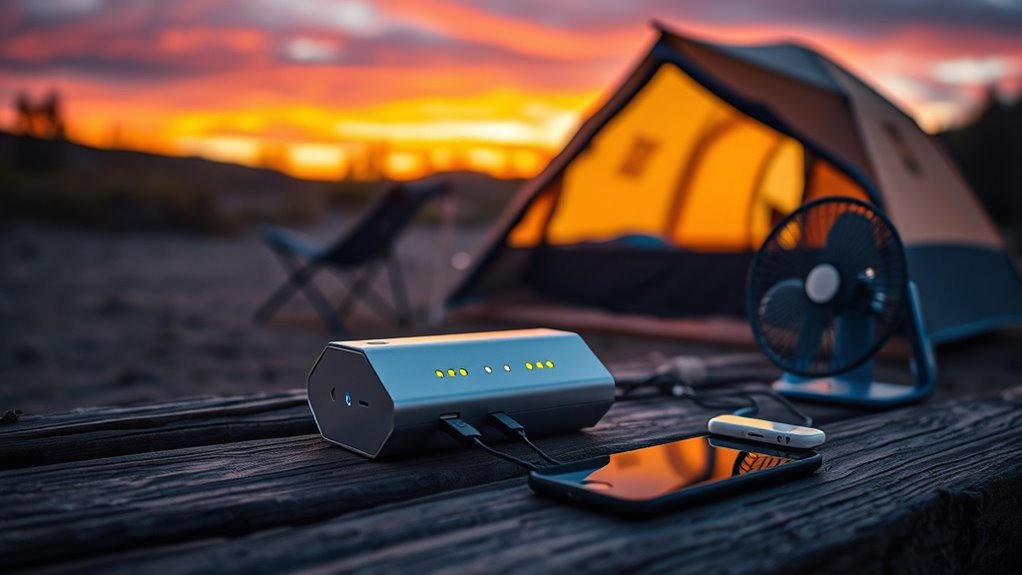
Knowing how much power your devices need is vital when choosing a power station. You’ll want to consider each device’s power consumption to make certain your station can handle the load. Devices like laptops and small appliances typically require less power, while larger tools or appliances need more. Pay attention to their battery life—longer battery life means fewer recharges, which is critical if you’re off-grid. Charging speed also matters; a station with rapid charging can quickly restore power, keeping your devices ready. By understanding your device’s power requirements, you can select a station that offers the right balance of capacity and efficiency. This guarantees your devices stay charged and ready to use without overloading or wasting energy. Additionally, understanding the power needs of various devices can help prevent potential overloads or damage to your power station.
Comparing Capacity Options: When Is a 1,000W Station Necessary?
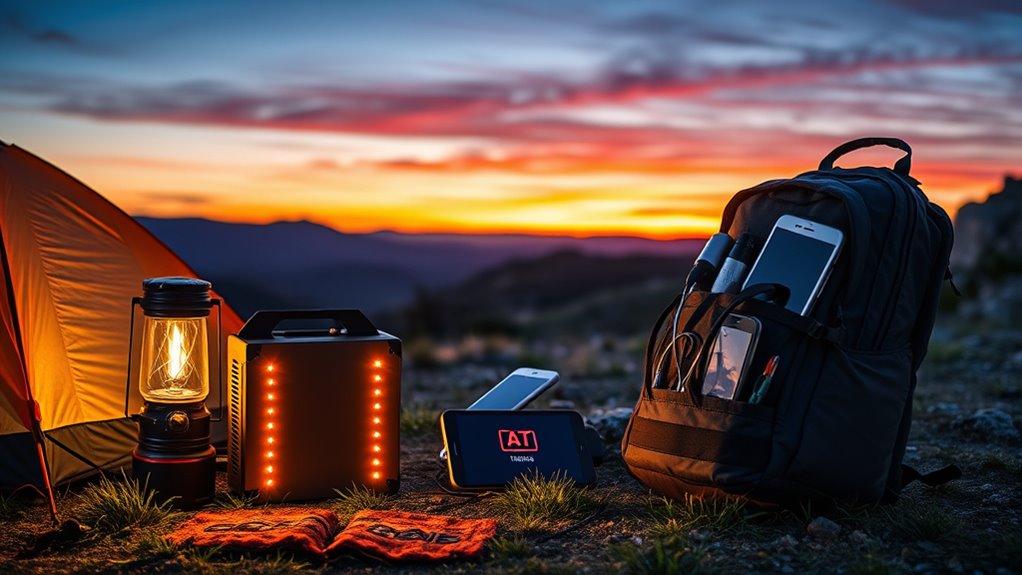
A 1,000W power station becomes necessary when you need to run multiple devices simultaneously or power larger appliances that demand more energy. If you rely on solar compatibility, a higher-capacity station guarantees you can store enough energy during sunny days to keep everything running. Consider your battery life needs—more wattage typically means longer operation times for high-energy devices. If you’re camping off-grid or preparing for power outages, a 1,000W unit provides the extra capacity to handle devices like refrigerators, laptops, and small power tools without constantly recharging. Think about whether your setup requires sustained use or just occasional power boosts. In these cases, a 1,000W station offers the balance of power, solar compatibility, and battery life to meet your demands effectively. Evaluating energy needs helps ensure you select the right size for your specific situation.
Weighing Portability Against Power: Finding the Right Balance
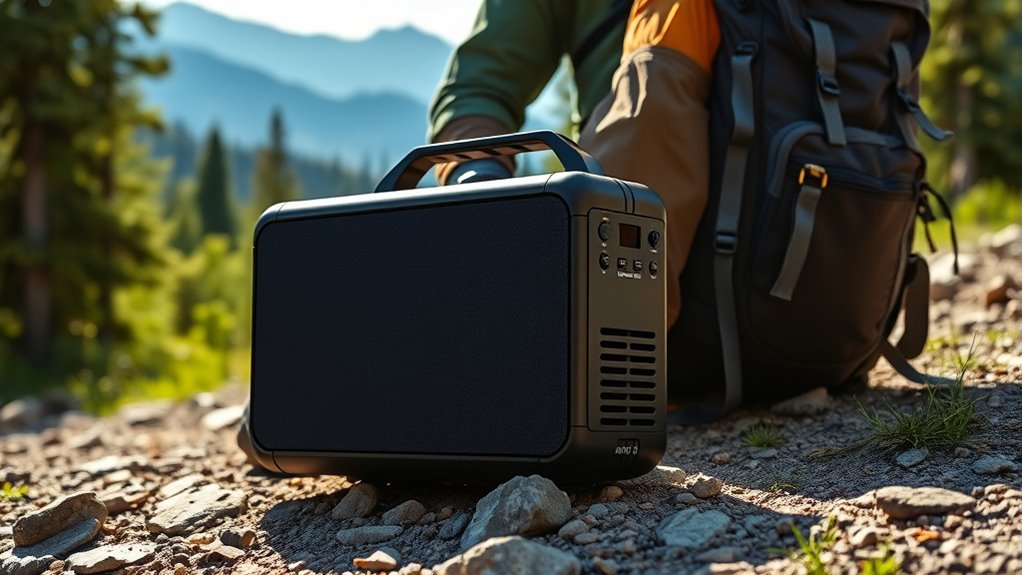
Choosing the right power station involves balancing size and portability to suit your needs. Advances in battery technology have made smaller units more powerful, making portable options viable for many uses. If you prioritize lightweight, easy-to-carry devices, opt for a compact station with efficient battery tech that still delivers enough power. Conversely, if you need longer runtimes or higher wattage, a larger, heavier model may be necessary, especially when integrating renewable energy sources like solar panels. Remember, portable units with renewable energy capabilities give you flexibility, but they often trade off some power capacity for ease of transport. Finding the right balance means evaluating your specific power requirements against how much weight and size you’re willing to carry. Regular maintenance and tips can also extend the lifespan and performance of your power station, ensuring it remains reliable over time.
Practical Scenarios: Situations That Call for Higher Wattage
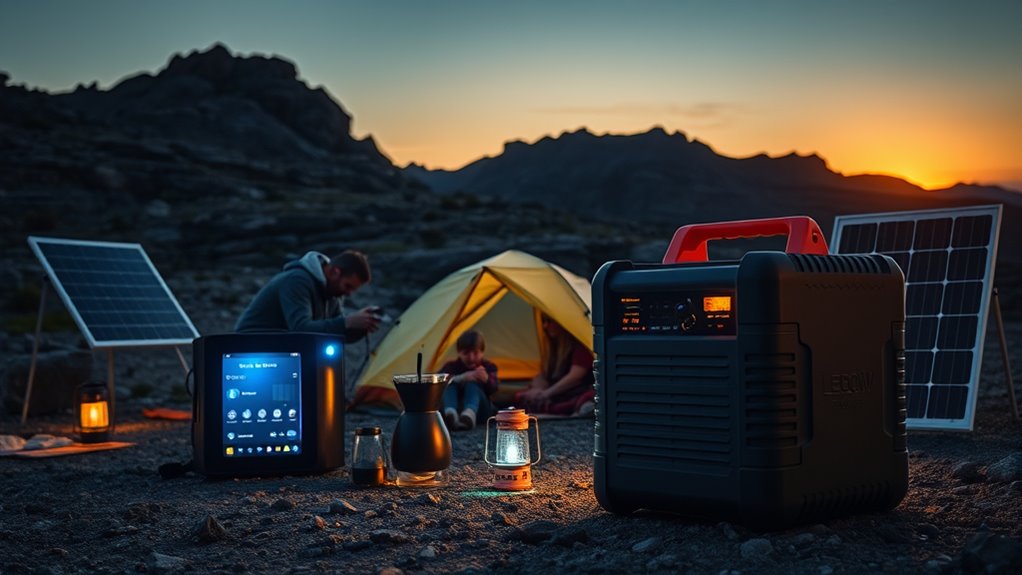
Certain situations demand higher wattage from your power station to keep essential devices running smoothly. If you’re powering multiple appliances simultaneously or handling high-demand equipment like power tools or large electronics, a higher wattage unit ensures reliability. Solar compatibility becomes vital if you plan to charge your station via solar panels, especially for extended off-grid use. Choosing a higher wattage station with efficient solar compatibility can maximize energy intake and reduce recharge times. Keep in mind, running devices at high power levels consistently can impact battery lifespan, so selecting a unit with appropriate capacity helps preserve your station’s longevity. In these scenarios, investing in a more powerful, durable model ensures your devices stay operational without compromise. Additionally, understanding your energy needs can help you select the most suitable wattage for your specific requirements.
Tips for Selecting the Perfect Size for Your Activities

Selecting the right size power station depends largely on your specific activities and device needs. To do this effectively, assess the total wattage of your devices and how long you’ll need power. If you plan to run devices for extended periods, prioritize models with better battery life to avoid frequent recharges. Consider charging speed as well; a power station with quick recharge capabilities ensures you’re not left powerless during long outings. Think about your main activities—camping, RV trips, or emergency backup—and match the power station’s capacity accordingly. Smaller units are portable but may have limited runtime, while larger ones handle heavier loads and longer use. By understanding your device requirements and usage patterns, you can select a power station that offers ideal battery life and efficient charging speed. Additionally, understanding the capacity of your power station can help you better estimate how many devices it can support simultaneously.
Frequently Asked Questions
Can a 1,000w Station Power All Household Appliances Simultaneously?
A 1,000W station can’t power all household appliances simultaneously, especially high-wattage devices. Your battery capacity limits how long it can run appliances, while charging speed affects how quickly it recharges for continuous use. For example, you might run smaller gadgets or a few essentials at once, but large appliances like refrigerators or microwave ovens will likely overload the station. Always check appliance wattage and station capacity before use.
How Long Can a 1,000w Power Station Run High-Demand Devices?
A 1,000W power station can run high-demand devices for a limited time, depending on their power consumption. Your battery life determines how long it can sustain the devices, while recharge time affects how quickly you can get it back to full capacity. For example, a device drawing close to 1,000W might run for about an hour, but if it consumes less, you’ll enjoy longer usage. Always check device wattage for accurate estimates.
Is a Higher Wattage Station More Energy-Efficient Over Time?
A higher wattage power station is like a sports car—powerful but not always more efficient. While it may deliver more energy quickly, battery efficiency and energy savings depend on your usage. Oversized stations can drain batteries faster if underused, reducing overall efficiency. So, choosing the right size helps maximize energy savings and prolong battery life, ensuring you get the most out of your power station without wasting power.
Are There Weight Differences Between 500W and 1,000w Power Stations?
When comparing 500W and 1,000W power stations, weight differences matter for portability. Generally, 1,000W models are heavier due to larger batteries and components, making them less portable. If you prioritize easy transport, a 500W station might suit you better. Consider the weight comparison and portability factors to choose a device that matches your needs without sacrificing convenience or power.
What Are the Long-Term Costs of Choosing a Higher Capacity Station?
Did you know that larger power stations can increase your long-term costs by up to 30%? Choosing a higher capacity station impacts your budget through higher initial costs and ongoing maintenance expenses. The cost implications include more frequent repairs and replacement parts, which can add up over time. Opting for a smaller, more appropriate capacity might save you money, reducing both upfront and maintenance expenses in the long run.
Conclusion
Before choosing a power station, question whether you truly need 1,000W or if a smaller model suffices. While some believe bigger is always better, research shows that overestimating your needs can lead to unnecessary weight and cost. By accurately evaluating your device power requirements, you’ll find a balance that offers enough power without excess bulk. In most cases, matching your station size to your actual needs proves both efficient and practical.
